Family
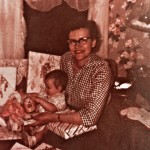 When my parents moved to Superior, Wisconsin, which is where my older sister, Cheryl Masterson and I were born, my mom was a young bride, who was experiencing the first days of marriage and the first time away from her family. I’m sure that was not really an easy time for her, but when she arrived in Superior, she was greeted by my dad’s family, who were the only people she knew there. If you have to move to a new city and state, it is nice to at least have someone that you know and can call family, as well as friend. My dad had a large family in the area with whom my mother became quite close, one of whom was my Aunt Doris Spencer, her sister-in-law, and my Uncle Bill’s wife. They spent a lot of time together, and really, had a number of “adventures” together.
When my parents moved to Superior, Wisconsin, which is where my older sister, Cheryl Masterson and I were born, my mom was a young bride, who was experiencing the first days of marriage and the first time away from her family. I’m sure that was not really an easy time for her, but when she arrived in Superior, she was greeted by my dad’s family, who were the only people she knew there. If you have to move to a new city and state, it is nice to at least have someone that you know and can call family, as well as friend. My dad had a large family in the area with whom my mother became quite close, one of whom was my Aunt Doris Spencer, her sister-in-law, and my Uncle Bill’s wife. They spent a lot of time together, and really, had a number of “adventures” together.
As young women, they were always weight conscious, and always on the latest diet. I’m sure that they thought it would be easier to diet with a buddy, and many of us have thought the same thing, but as we all know, dieting is never ease, and inevitably, they found themselves starving!! So, as a way of easing the cravings until they could eat something again, my Aunt Doris handed gave each of them one kernel of puffed wheat and said, “Here, this will tide us over until dinnertime!” Now, as we all know that would be like literally eating air, and it would not ease hunger pains in any way, but as every dieter knows, it was worth a try, because they didn’t want to mess up their diet.
 When we moved to Wyoming when I was a little over two years old, it was hard on a lot of people, but I think it was especially hard for my mom and Aunt Doris. While their “adventures” were sometimes silly and sometimes almost crazy, they always had a great time together, and they had become almost like sisters, not sisters-in-law. Aunt Doris and Uncle Bill visited us in Wyoming and we visited them in Wisconsin, but it was never quite the same. Then a few years ago, my sister, Cheryl and I took Mom to Wisconsin for a visit. it was so amazing to see the two sisters-in-law/friends together again, and I know they felt like it was an amazing reunion too. It was the last trip my Mom would make, but my Aunt Doris is still alive and going strong. Today is Aunt Doris’ 94th birthday. Happy birthday Aunt Doris!! Have a great day!! We love you!!
When we moved to Wyoming when I was a little over two years old, it was hard on a lot of people, but I think it was especially hard for my mom and Aunt Doris. While their “adventures” were sometimes silly and sometimes almost crazy, they always had a great time together, and they had become almost like sisters, not sisters-in-law. Aunt Doris and Uncle Bill visited us in Wyoming and we visited them in Wisconsin, but it was never quite the same. Then a few years ago, my sister, Cheryl and I took Mom to Wisconsin for a visit. it was so amazing to see the two sisters-in-law/friends together again, and I know they felt like it was an amazing reunion too. It was the last trip my Mom would make, but my Aunt Doris is still alive and going strong. Today is Aunt Doris’ 94th birthday. Happy birthday Aunt Doris!! Have a great day!! We love you!!

 My grandnephew, Bowen Parmely is a sweet little boy, who is the youngest of his parents three children, and their only son. That means that Bowen spends most of his days living in a largely female world, at least when his daddy, Eric Parmely isn’t home. Nevertheless, that does not mean anything, because Bowen’s mommy, Ashley Parmely, and his sisters, Reagan and Hattie are farm girls. They do all the things that farm girls do, from mucking the stalls, to feeding the animals, to stacking the hay, and any other things that need done on a farm. There is not much possibility of raising a sissy boy when he is being raised around tough women like his mom, and even his sisters, who are barely past toddler age themselves, and yet they are experienced farm girls.
My grandnephew, Bowen Parmely is a sweet little boy, who is the youngest of his parents three children, and their only son. That means that Bowen spends most of his days living in a largely female world, at least when his daddy, Eric Parmely isn’t home. Nevertheless, that does not mean anything, because Bowen’s mommy, Ashley Parmely, and his sisters, Reagan and Hattie are farm girls. They do all the things that farm girls do, from mucking the stalls, to feeding the animals, to stacking the hay, and any other things that need done on a farm. There is not much possibility of raising a sissy boy when he is being raised around tough women like his mom, and even his sisters, who are barely past toddler age themselves, and yet they are experienced farm girls.
Bowen’s upbringing has been a bit unusual in that while he couldn’t exactly help out on the farm, he could observe, and learn by doing so. As is typical for kids, work can look like fun…and can even seem like play. Kids like to mimic their parents, and younger siblings like to mimic older siblings, so just as his sisters learned the occupation of farming, so will Bowen. He has watched his sisters work with the animals, feeling somewhat cheated because he didn’t get to “play” too. Then, when his sisters were in school or otherwise occupied, his mommy would put Bowen in a backpack carrier, and they would go and do the work together. As I said, Bowen’s mommy is tough, and while everyone thought I was tough with a baby in a front pack and a baby in a backpack when I went shopping, looking at Ashley, I don’t think I was so tough. Carrying around a baby, who is growing as fast as Bowen has, while doing farm work is beyond tough, if you ask me.
As Bowen has grown, and learned to walk, he is becoming more of a help around the farm. Of course, he may 
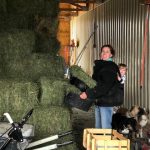 not be as much help as his mommy and daddy would like, and certainly not as much help as he will be as he get older, but every good worker had to start with that first little job, then as they grew, so did their responsibilities. Bowen will become an amazing little farm boy as time goes on, because like his parents, he will learn to love that lifestyle. I have no doubt that Bowen will grow up to be as big a help on the farm as his older sisters have. He can’t help but turn out great with his parents training. Today is Bowen’s first birthday. Happy birthday Bowen!! Have a great day!! We love you!!
not be as much help as his mommy and daddy would like, and certainly not as much help as he will be as he get older, but every good worker had to start with that first little job, then as they grew, so did their responsibilities. Bowen will become an amazing little farm boy as time goes on, because like his parents, he will learn to love that lifestyle. I have no doubt that Bowen will grow up to be as big a help on the farm as his older sisters have. He can’t help but turn out great with his parents training. Today is Bowen’s first birthday. Happy birthday Bowen!! Have a great day!! We love you!!

 The long awaited birth of the third child of the Duke and Duchess of Cambridge has finally arrived. It’s a prince. I am so excited to have a new royal cousin…my 16th cousin twice removed to be exact. Of course, we don’t know the baby boy’s name yet but he weighed in at 8 pounds 7 ounces, so he was a good sized boy. He is just perfect. It is always so exciting with one of my royal cousins has a new baby. There has been much speculation as to what the couple might name the little prince, with names like James, Phillip, and Arthur. The bookies have started the betting process, so everyone can be involved, Personally I like the names Michael, Phillip and Spencer. In fact I would like a some version of the three together. Time will tell, and until William and Kate inform the Queen of the name, no one else will get to know what it is, but from what I’ve read, the Queen will have no say in the baby’s name. As a grandmother, and soon-to-be great grandmother myself, while I have my own ideas about good baby names, I do not think it is my place to try to force my opinion, and in fact, when I have thought a name would not be the best on for the babies in my family, I have found out that each of their names seem to fit them perfectly. That said, no matter what the name is, it should be totally the decision of William and Kate. We just wish they would hurry up and tell us already!!
The long awaited birth of the third child of the Duke and Duchess of Cambridge has finally arrived. It’s a prince. I am so excited to have a new royal cousin…my 16th cousin twice removed to be exact. Of course, we don’t know the baby boy’s name yet but he weighed in at 8 pounds 7 ounces, so he was a good sized boy. He is just perfect. It is always so exciting with one of my royal cousins has a new baby. There has been much speculation as to what the couple might name the little prince, with names like James, Phillip, and Arthur. The bookies have started the betting process, so everyone can be involved, Personally I like the names Michael, Phillip and Spencer. In fact I would like a some version of the three together. Time will tell, and until William and Kate inform the Queen of the name, no one else will get to know what it is, but from what I’ve read, the Queen will have no say in the baby’s name. As a grandmother, and soon-to-be great grandmother myself, while I have my own ideas about good baby names, I do not think it is my place to try to force my opinion, and in fact, when I have thought a name would not be the best on for the babies in my family, I have found out that each of their names seem to fit them perfectly. That said, no matter what the name is, it should be totally the decision of William and Kate. We just wish they would hurry up and tell us already!!
With the birth of this baby boy, history will be made again. This new baby will be 5th in line to the throne of England, following his grandpa, Prince Charles; his dad, Prince William; his brother, Prince George; and his sister, Princess Charlotte. In times past, Charlotte would have fallen after this new baby, but the law changed before her birth, and she now holds her line in the succession to the throne. Many people are not sure how they feel about that, but since her great grandmother, Queen Elizabeth has successfully ruled England for many years, it would be hard to dispute Princess Charlotte’s ability should that position ever arise. This baby also moves Prince Harry, William’s brother, to 6th place in the line of succession, which pretty much guarantees that he will never be the King of England, unless something huge happens, which I pray it never does…obviously. 

So, as an eventful first day of life comes to an end for the little prince, who was born of Saint George’s Day, a big holiday in England, we go to sleep still wondering what this little man will be named. Not that he really cares either way right now. After all, he has had a busy day, and all he really wants is dinner and a soft bed. Happy birthday sweet little HRH Prince of Cambridge, which is his official title. We look forward to knowing your name very soon. Congratulations to the Duke and Duchess of Cambridge. We are so happy for you!!
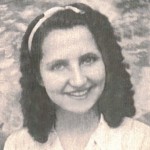 My Aunt Delores Johnson was always a sweet, kind, loving, and sincerely genuine person. She loved her family, and she made sure they knew it. From her young years she was a joy to her parents and to her siblings, always finding ways to make them laugh. This endeared her to them for the rest of her life.
My Aunt Delores Johnson was always a sweet, kind, loving, and sincerely genuine person. She loved her family, and she made sure they knew it. From her young years she was a joy to her parents and to her siblings, always finding ways to make them laugh. This endeared her to them for the rest of her life.
Aunt Dee, as she was always known to most people, liked sweet rolls. When she was sick, and didn’t feel like eating, of course, the sweet rolls were not something she could handle, so when she finally asked for sweet rolls, it was a great relief, because it meant that she was getting better. I’m sure that sweet rolls were offered to her when she was sick, in the hope that she would want them, thus indicating that she was on the mend.
Aunt Dee loved kids and never spoke a harsh word to any of us…at least not to her nieces and nephews. I can’t 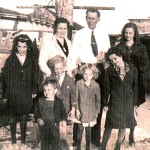 speak to how she might have been if one of her four children, Ellen, Elmer, Darla, or Delwin were in trouble, but then what parent hasn’t yelled at their child at one point or another. Nevertheless, her children always knew how much she loved them, as did all of her nieces and nephews.
speak to how she might have been if one of her four children, Ellen, Elmer, Darla, or Delwin were in trouble, but then what parent hasn’t yelled at their child at one point or another. Nevertheless, her children always knew how much she loved them, as did all of her nieces and nephews.
Aunt Dee and my mother, Collene Spencer, who was her younger sister, were good friends, on top of being sisters. They just liked spending time together, and I can’t help but think that they are having a great time in Heaven, along with their husbands, Elmer Johnson, and my dad Allen Spencer; their parents, George and Hattie Byer; siblings, Evelyn Hushman and Larry Byer, as well as brothers-in-law, Jack McDaniels and Bill Beadle. I’m sure there’s a lot of laughter going on, because that’s the kind of thing that always happens when Aunt Dee is around. There is joy in Heaven because they are all together  again. Personally, I can’t wait to get there myself, to see them all again.
again. Personally, I can’t wait to get there myself, to see them all again.
Aunt Dee always had something nice to say. Like everyone in this life, Aunt Dee had her share of storms, but she weathered them all, and was still always kind to the underdog. She was a very good-hearted woman, and we all loved her very much. In 1996, Aunt Dee was diagnosed with Brain Cancer. This time there would be no request for sweet rolls to set at ease the minds of all who loved her. Aunt Dee passed away on October 6, 1996, and I still can’t believe she is gone. I miss her sweet smile and her joyful ways. Today would have been her 87th birthday. Happy birthday in Heaven Aunt Dee. We love and miss you very much.
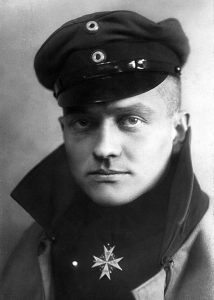 Who fired the shot that killed Richthofen? And who was Richthofen anyway? First, Richthofen was also known as the Red Baron. Manfred Albrecht Freiherr von Richthofen was born on May 2, 1892. He was a fighter pilot with the German Air Force during World War I, and is considered the ace-of-aces of the war. He was officially credited with 80 air combat victories.
Who fired the shot that killed Richthofen? And who was Richthofen anyway? First, Richthofen was also known as the Red Baron. Manfred Albrecht Freiherr von Richthofen was born on May 2, 1892. He was a fighter pilot with the German Air Force during World War I, and is considered the ace-of-aces of the war. He was officially credited with 80 air combat victories.
Nevertheless, as it goes with fighter pilots, their lives are always in jeopardy, and not all of them will come out of war alive. Such was the case with the Red Baron. The end came for him on April 21, 1918. It’s possible that he made mistakes on that final flight. Richthofen was a highly experienced and skilled fighter pilot, who was fully aware of the risk from ground fire. Furthermore, he concurred with the rules of air fighting created by his late mentor Boelcke, who specifically advised pilots not to take unnecessary risks. With that in mind, one must wonder if Richthofen’s judgement during his last combat was unsound or somehow compromised.
Several theories have been proposed to account for his behavior. In 1999, a German medical researcher, Henning Allmers, published an article in the British medical journal The Lancet, suggesting it was likely that brain damage from the head wound Richthofen suffered in July 1917, played a part in the Red Baron’s death. This was supported by a 2004 paper by researchers at the University of Texas. Richthofen’s behavior after his injury was noted as consistent with brain-injured patients, and such an injury could account for his perceived lack of judgement on his final flight…a flight in which he was flying too low over enemy territory and suffering target fixation, which is an attentional phenomenon observed in humans in which an individual becomes so focused on an observed object, that they inadvertently increase their risk of colliding with the object.
Still, the biggest question is not why the Red Baron made the mistake that would get him killed, but rather who killed him. The RAF credited Arthur Roy Brown, an RNAS lieutenant with shooting down the Red Baron, but it is 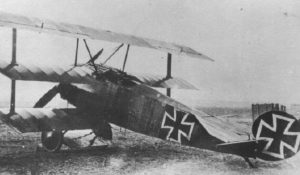 now generally agreed that the bullet that hit the Red Baron was fired from the ground. The Red Baron died following an extremely serious and inevitably fatal chest wound from a single bullet, penetrating from the right armpit and resurfacing from his left chest. Brown’s attack was from behind and above, and from Red Baron’s left. Even more conclusively, Red Baron could not have continued his pursuit for as long as he did…up to two minutes…had this wound come from Brown’s guns. Brown himself never spoke much about what happened that day, claiming, “There is no point in me commenting, as the evidence is already out there.”
now generally agreed that the bullet that hit the Red Baron was fired from the ground. The Red Baron died following an extremely serious and inevitably fatal chest wound from a single bullet, penetrating from the right armpit and resurfacing from his left chest. Brown’s attack was from behind and above, and from Red Baron’s left. Even more conclusively, Red Baron could not have continued his pursuit for as long as he did…up to two minutes…had this wound come from Brown’s guns. Brown himself never spoke much about what happened that day, claiming, “There is no point in me commenting, as the evidence is already out there.”
Many sources, including a 1998 article by Geoffrey Miller, a physician and historian of military medicine, and a 2002 British Channel 4 documentary, have suggested that Sergeant Cedric Popkin was the person most likely to have killed Richthofen. Popkin was an anti-aircraft (AA) machine gunner with the Australian 24th Machine Gun Company, and was using a Vickers gun. He fired at Richthofen’s aircraft on two occasions…first as the Baron was heading straight at his position, and then at long range from the right. Given the nature of Richthofen’s wounds, Popkin was in a position to fire the fatal shot, when the pilot passed him for a second time, on the right. Some confusion has been caused by a letter that Popkin wrote, in 1935, to an Australian official historian. It stated Popkin’s belief that he had fired the fatal shot as Red Baron flew straight at his position. In the latter respect, Popkin was incorrect. The bullet that caused the Baron’s death came from the side.
A 2002 Discovery Channel documentary suggests that Gunner W. J. “Snowy” Evans, a Lewis machine gunner with the 53rd Battery, 14th Field Artillery Brigade, Royal Australian Artillery is likely to have killed Red Baron. 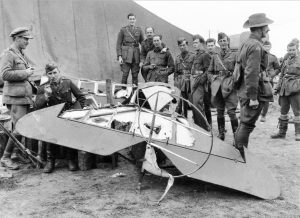 Miller and the Channel 4 documentary dismiss this theory, because of the angle from which Evans fired at Richthofen.
Miller and the Channel 4 documentary dismiss this theory, because of the angle from which Evans fired at Richthofen.
Other sources have suggested that Gunner Robert Buie, also of the 53rd Battery, may have fired the fatal shot. There is little support for this theory. In 2007, a municipality in Sydney recognized Buie as the man who shot down Richthofen, placing a plaque near Buie’s former home. Buie, who died in 1964, has never been officially recognized in any other way. I suppose that, in reality, we will never really know for sure who killed Red Baron, but the theories present an interesting puzzle, and one that will most likely never be solved.
 The Gallipoli campaign took place between April 1915 and December 1915 in an effort to take the Dardanelles from the Turkish Ottoman Empire…an ally of Germany and Austria, and thus force it out of the war. About 60,000 Australians and 18,000 New Zealanders were part of a larger British force. Among the wounded were some 26,000 Australians and 7,571 New Zealanders, while 7,594 Australians and 2,431 New Zealanders were killed. Numerically, Gallipoli was a minor campaign, but it took on considerable national and personal importance to the Australians and New Zealanders who fought there.
The Gallipoli campaign took place between April 1915 and December 1915 in an effort to take the Dardanelles from the Turkish Ottoman Empire…an ally of Germany and Austria, and thus force it out of the war. About 60,000 Australians and 18,000 New Zealanders were part of a larger British force. Among the wounded were some 26,000 Australians and 7,571 New Zealanders, while 7,594 Australians and 2,431 New Zealanders were killed. Numerically, Gallipoli was a minor campaign, but it took on considerable national and personal importance to the Australians and New Zealanders who fought there.
The Gallipoli Campaign was Australia’s and New Zealand’s introduction to the Great War. Many Australians and New Zealanders fought on the Peninsula from the day of the landings (April 25, 1915) until the evacuation on December 20, 1915. The 25th April is the New Zealand equivalent of Armistice Day and is marked as the ANZAC day in both countries with Dawn Parades and  other services in every city and town. Shops are closed in the morning. It is a very important day to Australians and New Zealanders for a variety of reasons that have changed and transmuted over the years. This campaign, while small in losses, was huge in the hearts of the Australians and New Zealanders.
other services in every city and town. Shops are closed in the morning. It is a very important day to Australians and New Zealanders for a variety of reasons that have changed and transmuted over the years. This campaign, while small in losses, was huge in the hearts of the Australians and New Zealanders.
While many losses came out of this campaign, it seems that there were two who were saved…potentially anyway. After the campaign was over, and people were wandering the area, someone came across an unusual, and seriously rare, find. There on the ground were two bullets that had collided with each other in mid-air, thus saving the lives of the two combatants who fired the rounds. Obviously, they could have been hit by another round, in which case the mid-air collision only slightly prolonged their lives. At least this scenario might be what you would think. The reality is that you would be wrong. Taking a look closer at the bullets, it is quite obvious that one round collided with 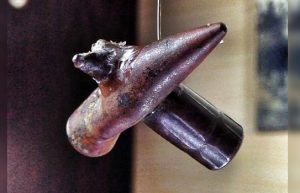 another. But the round on the left doesn’t have any rifling on it, whereas the round on the right does. They collided, but in reality, the round on the left probably wasn’t moving as fast as an actual speeding bullet. Maybe it was part of a clip on an ANZAC soldiers webgear as he was in an attack, or some other bizarre reason. But this most certainly wasn’t the intersection of two trajectories between the lines…making such a collision between two bullets even more rare. Nevertheless, the picture itself is quite interesting, and would have caught the eye of anyone looking at it. How they got there really makes no difference, but the fact that they were found on the Gallipoli battlefield makes them an interesting find. If you ask me, it is still a very rare occurrence.
another. But the round on the left doesn’t have any rifling on it, whereas the round on the right does. They collided, but in reality, the round on the left probably wasn’t moving as fast as an actual speeding bullet. Maybe it was part of a clip on an ANZAC soldiers webgear as he was in an attack, or some other bizarre reason. But this most certainly wasn’t the intersection of two trajectories between the lines…making such a collision between two bullets even more rare. Nevertheless, the picture itself is quite interesting, and would have caught the eye of anyone looking at it. How they got there really makes no difference, but the fact that they were found on the Gallipoli battlefield makes them an interesting find. If you ask me, it is still a very rare occurrence.
 Stagecoach drivers like Charley Parkhurst were tough as nails. Not everyone could handle a stagecoach. The stagecoach driver was respected…sometimes even more than was the millionaire statesman who might be riding beside him, or anyone else who had been given that honor. Parkhurst had been through the good times and bad times of driving stagecoach. Twice, Charley was held up. The first time, he was forced to throw down his strongbox because he was unarmed. The second time, he was prepared. When a road agent ordered the stage to stop and commanded Charley to throw down its strongbox, Parkhurst leveled a shotgun blast into the chest of the outlaw, whipped his horses into a full gallop, and left the bandit in the road.
Stagecoach drivers like Charley Parkhurst were tough as nails. Not everyone could handle a stagecoach. The stagecoach driver was respected…sometimes even more than was the millionaire statesman who might be riding beside him, or anyone else who had been given that honor. Parkhurst had been through the good times and bad times of driving stagecoach. Twice, Charley was held up. The first time, he was forced to throw down his strongbox because he was unarmed. The second time, he was prepared. When a road agent ordered the stage to stop and commanded Charley to throw down its strongbox, Parkhurst leveled a shotgun blast into the chest of the outlaw, whipped his horses into a full gallop, and left the bandit in the road.
Charley Parkhurst was one of the more skillful stagecoach drivers, not only in  California, but throughout the west. He was often called “One-eyed” or “Cockeyed” Charley, because he had lost an eye when kicked by a horse. He drove a stagecoach in California for 20 years. One-eyed Charley was known as one of the toughest, roughest, and the most daring of all stagecoach drivers. Like most drivers, he was proud of his skill in the extremely difficult job as “whip.” A “whip” is what stagecoach drivers were often called. Proper handling of the horses and the great coaches was an art that required much practice, experience, and not the least, courage. Whips received high salaries for the times, sometimes as much as $125 a month, plus room and board. While most stage drivers were sober, at least while on duty, nearly all were fond of an occasional “eye opener.” A good driver was the captain of his craft. His timid passengers feared him. He was
California, but throughout the west. He was often called “One-eyed” or “Cockeyed” Charley, because he had lost an eye when kicked by a horse. He drove a stagecoach in California for 20 years. One-eyed Charley was known as one of the toughest, roughest, and the most daring of all stagecoach drivers. Like most drivers, he was proud of his skill in the extremely difficult job as “whip.” A “whip” is what stagecoach drivers were often called. Proper handling of the horses and the great coaches was an art that required much practice, experience, and not the least, courage. Whips received high salaries for the times, sometimes as much as $125 a month, plus room and board. While most stage drivers were sober, at least while on duty, nearly all were fond of an occasional “eye opener.” A good driver was the captain of his craft. His timid passengers feared him. He was  held in awe by stable boys, and was the trusty agent of his employer…and Charley was the best.
held in awe by stable boys, and was the trusty agent of his employer…and Charley was the best.
Nevertheless, little was really known about Charley Parkhurst before or after he came to California. It wasn’t until his body was prepared for burial that his true secret was discovered. Charlotte “Charley” Parkhurst was a woman. One doctor claimed that at some point in her life, she had been a mother. Unknowingly, Parkhurst could claim a national first. After voting on Election Day, November 3, 1868, Charley was probably the first woman to cast a ballot in any election. It wasn’t until 52 years later that the right to vote was guaranteed to women by the nineteenth amendment.
 For many years, I have admired Albert Einstein. His mind and his level of intelligence intrigued me, as did his quirkiness. When you think of a genius, your mind automatically produces a picture of a very organized person, who is able to handle any situation, but even geniuses have their issues with things. One well know “weakness” for Einstein was the fact that if something can be written down, it need not take up space in his brain. His brain was very full after all, and clutter was always an issue. That said, if he couldn’t find his train ticket…for the train he took every day from home to work and back…he didn’t know at which stop to get off, because he relied on his ticket to tell him that. I don’t think most of us could even begin to filter our brain in such a way…but Einstein could, and did.
For many years, I have admired Albert Einstein. His mind and his level of intelligence intrigued me, as did his quirkiness. When you think of a genius, your mind automatically produces a picture of a very organized person, who is able to handle any situation, but even geniuses have their issues with things. One well know “weakness” for Einstein was the fact that if something can be written down, it need not take up space in his brain. His brain was very full after all, and clutter was always an issue. That said, if he couldn’t find his train ticket…for the train he took every day from home to work and back…he didn’t know at which stop to get off, because he relied on his ticket to tell him that. I don’t think most of us could even begin to filter our brain in such a way…but Einstein could, and did.
Einstein was a gifted scientist and mathematician. He was most famous for his theory of relativity and the resulting formula relating mass and energy…E = MC². He was the winner of 1921 Nobel Prize in physics for his work on the photoelectric effect, which is also known as the Hertz effect. Einstein was born in Ulm, in the Kingdom of Württemberg in the German Empire, on March 14, 1879. His parents were Hermann Einstein, a salesman and engineer, and Pauline Koch. He didn’t feel the need to celebrate his birthday,saying “It is a known fact that I was born, and that is all that is necessary.” Friends, colleagues and complete strangers still felt the need to send telegrams, cards, letters, gifts, and an elaborate birthday cake.
Being a Jewish man, circumstances in Germany became life threatening for Einstein in the early 1930s, so early in 1933, while on a trip to the United States, he knew he could not go home again, so he moved permanently  to the United States, and worked at Princeton University…a career that would take him to the end of his life on April 18, 1955. Einstein could have been saved, but when he was asked if he wanted to undergo surgery, he refused, saying, “I want to go when I want to go. It is tasteless to prolong life artificially. I have done my share; it is time to go. I will do it elegantly.” After an autopsy, Einstein’s body was cremated and his ashes spread in an undisclosed location.
to the United States, and worked at Princeton University…a career that would take him to the end of his life on April 18, 1955. Einstein could have been saved, but when he was asked if he wanted to undergo surgery, he refused, saying, “I want to go when I want to go. It is tasteless to prolong life artificially. I have done my share; it is time to go. I will do it elegantly.” After an autopsy, Einstein’s body was cremated and his ashes spread in an undisclosed location.
After his passing, another of the multiple quirky aspects of Einstein’s personality came to light when LIFE magazine wrote about a famous picture taken in Albert Einstein’s Princeton office. Einstein’s desk was just as he left it. Here, the picture says, is where Einstein worked, dreamed, lived his singular, principled life to its fullest. “When I was young, all I wanted and expected from life was to sit quietly in some corner doing my work without the public paying attention to me,” said Einstein after being honored at a social function. “And now see what has become of me.”
When I look and Einstein’s desk, it takes me back to the many times my own desk has looked exactly like that. It is another way that the famed scientific and mathematical genius and I are alike. Now, I do not claim to have the IQ of this man, but we do have a few things in common, and the ability to work on top of a stack of papers seems to be one of them. Maybe that and the ability to somewhat filter things out of my mind if they are stored in my phone which could be the same thing as filtering because I have it written down. And because of my shy side, I suppose I can understand his concern over public attention, and yet knowing that sometimes it can’t be helped. When I look at his desk, I can see a man whose mind was fill with many thoughts, making it easy to 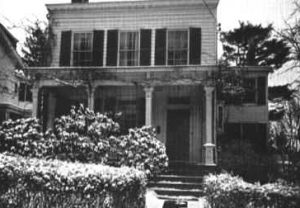 lose himself in his thoughts to the point of seeming to ignore those around him. Those who met Einstein recalled his human side. He “walked to work or rode the bus in bad weather; visited the neighbors’ newborn kittens; greeted carolers on winter nights; refused to update his eyeglass prescription; and declined to wear socks because they would get holes in them. But he didn’t seem to mind fuzzy slippers!” He was his own man with his own ideas, and if those ideas didn’t make sense to those around him, it was simply not his problem. On April 18, 1955, Albert Einstein died soon after a blood vessel burst near his heart. The world mourned Einstein’s death, but true to form, at his request, his office and house were not turned into memorials.
lose himself in his thoughts to the point of seeming to ignore those around him. Those who met Einstein recalled his human side. He “walked to work or rode the bus in bad weather; visited the neighbors’ newborn kittens; greeted carolers on winter nights; refused to update his eyeglass prescription; and declined to wear socks because they would get holes in them. But he didn’t seem to mind fuzzy slippers!” He was his own man with his own ideas, and if those ideas didn’t make sense to those around him, it was simply not his problem. On April 18, 1955, Albert Einstein died soon after a blood vessel burst near his heart. The world mourned Einstein’s death, but true to form, at his request, his office and house were not turned into memorials.
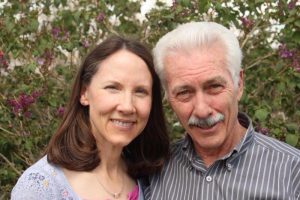 Brian Cratty, who is my sister-in-law Jennifer Parmely’s partner is a somewhat quiet man, who is very likable. They share so many common interests, the biggest of which is the love of the outdoors. That means hiking, skiing, and of course, Brian’s favorite, bicycling. They love to be in the mountains, and so when the chance came up to buy a cabin on Casper Mountain, they took it. For the past few years, they have been spending time fixing up their little cabin so that it can be a place where they can gather with their family and just enjoy the beauty of the mountain.
Brian Cratty, who is my sister-in-law Jennifer Parmely’s partner is a somewhat quiet man, who is very likable. They share so many common interests, the biggest of which is the love of the outdoors. That means hiking, skiing, and of course, Brian’s favorite, bicycling. They love to be in the mountains, and so when the chance came up to buy a cabin on Casper Mountain, they took it. For the past few years, they have been spending time fixing up their little cabin so that it can be a place where they can gather with their family and just enjoy the beauty of the mountain.
Brian is a retired pilot, so he likes those high altitudes, but being on the mountain is much different from flying above it. Still, there is something about being up there. Live is different on the mountain. It’s quieter and more relaxed. The air is fresh and clean, and the trees smell amazing. Who could blame Brian for wanting a cabin up there. The area where their cabin is, has an abundance of trees, and it is very peaceful. The location is perfect for both hiking and bicycling because it is near a trail.
Brian and Jennifer are so good together. They are two people who are happily going in the same direction, and 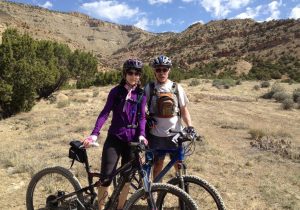 that is always a good thing. Their blended family seems to do well with it too, even though the kids are all grown and living on their own. The thing I think I like best about Brian, however, is his caring nature. He is so good to Jennifer, and that goes a long way when a guy joins a family. Being the new guy on the block is never easy, but when you have a kindness about you, and you don’t force your own way, it gets a whole lot easier. That is exactly the kind of guy Brian is. I remember when I first met him. He wasn’t loud and boisterous, but had a relaxed way, or maybe such a big family was simply overwhelming. Either way, we really think he is a great addition to the family. Today is Brian’s birthday. Happy birthday Brian! Have a great day!! We love you!
that is always a good thing. Their blended family seems to do well with it too, even though the kids are all grown and living on their own. The thing I think I like best about Brian, however, is his caring nature. He is so good to Jennifer, and that goes a long way when a guy joins a family. Being the new guy on the block is never easy, but when you have a kindness about you, and you don’t force your own way, it gets a whole lot easier. That is exactly the kind of guy Brian is. I remember when I first met him. He wasn’t loud and boisterous, but had a relaxed way, or maybe such a big family was simply overwhelming. Either way, we really think he is a great addition to the family. Today is Brian’s birthday. Happy birthday Brian! Have a great day!! We love you!
 It was a typical day in Texas City, Texas…a port city in Galveston Bay. April was always warm, in the mid-70s, so it was perfect outdoor weather. Fires around the docks were a fairly common occurrence in Texas City, and it was not unusual for residents to travel down to the docks to watch the fires and the firemen working. Fires tend to attract the casual observer as well as the local news agencies. This day started out just as any other typical Texas day, but all that would change very soon. On the morning of April 16, 1947 a fire broke out on the S.S. Grandcamp. The fire produced a dense, brilliantly colored smoke that could be seen all over town. On board Grandcamp, among other things, was a supply of ammonium nitrate, which was producing the brilliant colors. The ship was docked in the Texas City port, so the smoke could be seen all over town. This fire, like any other, brought anybody who had any free time down to the dock to watch the action. This would be a fatal mistake for many of the bystanders.
It was a typical day in Texas City, Texas…a port city in Galveston Bay. April was always warm, in the mid-70s, so it was perfect outdoor weather. Fires around the docks were a fairly common occurrence in Texas City, and it was not unusual for residents to travel down to the docks to watch the fires and the firemen working. Fires tend to attract the casual observer as well as the local news agencies. This day started out just as any other typical Texas day, but all that would change very soon. On the morning of April 16, 1947 a fire broke out on the S.S. Grandcamp. The fire produced a dense, brilliantly colored smoke that could be seen all over town. On board Grandcamp, among other things, was a supply of ammonium nitrate, which was producing the brilliant colors. The ship was docked in the Texas City port, so the smoke could be seen all over town. This fire, like any other, brought anybody who had any free time down to the dock to watch the action. This would be a fatal mistake for many of the bystanders.
The ammonium nitrate on board the Grandcamp detonated at 9:12 am, blowing he ship apart and sending the cargo of peanuts, tobacco, twine, bunker oil and the remaining bags of ammonium nitrate 2,000 to 3,000 feet into the air. Fireballs streaked across the sky and could be seen for miles across Galveston Bay as molten ship fragments erupted out of the pier. The blast sent a fifteen foot tidal wave crashing onto the dock and flooding the surrounding area. Windows were shattered in Houston, 40 miles to the north, and people in Louisiana felt the shock 250 miles away. Most of the buildings closest to the blast were flattened, and there were many more that had doors and roofs blown off. The Monsanto plant which was only three hundred feet away, was destroyed by the blast. Most of the Texas City Terminal Railways’ warehouses along the docks were destroyed. Hundreds of employees, pedestrians and bystanders were killed. At the time of the Grandcamp’s explosion, only two additional vessels were docked in port…the S.S. High Flyer and the Wilson B. Keene, both American C-2 cargo ships similar to the Grandcamp.
The intensity of the blast sent shrapnel tearing into the surrounding area. Flaming debris ignited giant tanks full 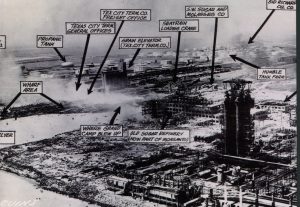 of oil and chemicals stored at the refineries, causing a set of secondary fires and smaller explosions. The Longhorn II, a barge anchored in port, was lifted out of the water by the sheer force of the explosion and landed 100 feet away on the shore. Buildings blazed long after the initial explosion, provoking large scale emergency relief efforts throughout the day, that night, and into the following day. The fires in nearby industrial buildings and chemical plants spread the destruction even farther. The chief and 27 firefighters from the Texas City Fire Department were killed in the initial blast. Official estimates put the death toll at 567 and injuries at more than 5,000. Some of the dead were never identified, and some may never have been found at all.
of oil and chemicals stored at the refineries, causing a set of secondary fires and smaller explosions. The Longhorn II, a barge anchored in port, was lifted out of the water by the sheer force of the explosion and landed 100 feet away on the shore. Buildings blazed long after the initial explosion, provoking large scale emergency relief efforts throughout the day, that night, and into the following day. The fires in nearby industrial buildings and chemical plants spread the destruction even farther. The chief and 27 firefighters from the Texas City Fire Department were killed in the initial blast. Official estimates put the death toll at 567 and injuries at more than 5,000. Some of the dead were never identified, and some may never have been found at all.
The blast registered on a seismograph as far away as Denver, Colorado. Dockworker Pete Suderman remembers flying thirty feet as the blast carried him and several of the dock’s three-inch wooden planks across the pier. Nattie Morrow was in her home with her two children and sister-in-law Sadie. She watched the billowing smoke near the Monsanto plant from her back porch just prior to the blast. “Suddenly a thundering boom sounded, and seconds later the door ripped off its facing, skidded across the kitchen floor, and slammed down onto the table where I sat with the baby. The house toppled to one side and sat off its piers at a crazy angle. Broken glass filled the air, and we didn’t know what was happening.”
At the time of the explosion, phone services in Texas City were not working because of a telephone operators’ strike. When the operators learned of the accident, they quickly went back to work, but the strike caused an initial delay in coordinating rescue efforts. Once operators began calling for help, rescue workers from all over the area began responding immediately. The U.S. Army, Navy, Coast Guard, Marine Reserve and the Texas National Guard all sent personnel, including doctors, nurses and ambulances. The University of Texas Medical Branch at Galveston sent doctors, nurses, and medical students. Firefighters from Galveston, Houston, Fort Crockett, Ellington Field, and surrounding towns arrived to help. The cities of Galveston, Houston and San Antonio sent policemen to assist the Texas City Police Department in maintaining order after the explosion. The U.S. Army flew in blood  plasma, gas masks, food, and other supplies, provided bull-dozers to begin clearing the wreckage, and set up temporary housing for the survivors at Camp Wallace in Hitchcock. The Red Cross, Salvation Army and the Boy and Girl Scouts of America sent a flood of volunteers who provided first aid, food, water and comfort to city residents. Volunteers from other local organizations, and others who were not part of any organization, felt compelled to help. There was no operational hospital in Texas City at the time of the disaster, so volunteers converted city hall and chamber of commerce buildings into makeshift infirmaries. Many wounded were evacuated to John Sealy Hospital in Galveston, the hospital at Fort Crockett, and hospitals in Houston.
plasma, gas masks, food, and other supplies, provided bull-dozers to begin clearing the wreckage, and set up temporary housing for the survivors at Camp Wallace in Hitchcock. The Red Cross, Salvation Army and the Boy and Girl Scouts of America sent a flood of volunteers who provided first aid, food, water and comfort to city residents. Volunteers from other local organizations, and others who were not part of any organization, felt compelled to help. There was no operational hospital in Texas City at the time of the disaster, so volunteers converted city hall and chamber of commerce buildings into makeshift infirmaries. Many wounded were evacuated to John Sealy Hospital in Galveston, the hospital at Fort Crockett, and hospitals in Houston.

